Decorative variety of honeysuckle "Alpine"
Interest in shrubs with original decor is explained by the ability to create beautiful compositions with their help in a personal garden or summer cottage. Among the list of picturesque garden plants, Alpine honeysuckle stands out. In the wild it is found in mountain forests. This explains the unpretentiousness of the varieties bred for cultural cultivation based on this shrub.
Description of alpine honeysuckle varieties
Alpine honeysuckle - Lonicera alpigena (lat.) belongs to the Honeysuckle family.
The natural habitat of the unpretentious ornamental shrub is located in the south and center of Europe.
In 2004, Russian breeders who conducted research in the Botanical Garden at the Belgorod National Research University obtained elite forms of alpine honeysuckle. They were given the following varietal names: Alania, Aidar, Ladybug. The same group includes Hedgehog, Kalitva, Korochanka, as well as Linda, Maris, Firefly.
Alpine honeysuckle: description, characteristics, appearance
Alpine honeysuckle is a deciduous shrub reaching a height of 2 m.
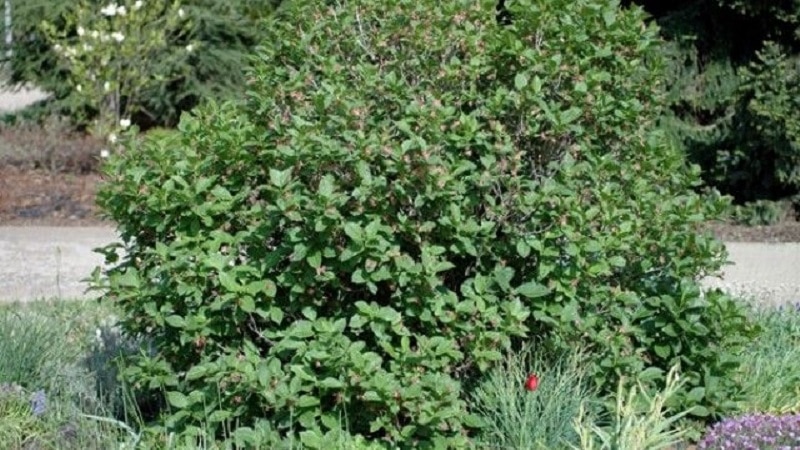
Dark green dense leaves with a shiny surface have an obovate shape. They are attached to the stems by long petioles. Thanks to its rich color and numerous leaf blades, the compact, rounded crown retains its attractive appearance throughout the growing season.
Light yellow buds with a slight reddish tint without aroma are formed on peduncles 2-5 cm long.The spherical fruits, fused in pairs, with a shiny scarlet surface, are attached to long stalks.
Features of the use of this variety
All forms of alpine honeysuckle belong to ornamental varieties of shrubs. They are widespread in landscape design.
Them juicy bright fruits, reminiscent of cherries, inedible. They add additional charm to the bushes, standing out against the backdrop of rich green foliage. Although the berries cannot be eaten, they do not contain toxic compounds.
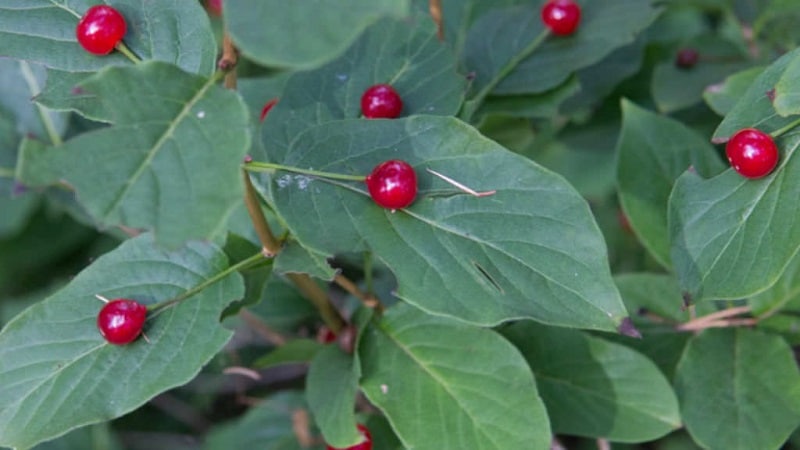
Application in landscape design
Alpine honeysuckle can be found in parks, shrub mixborders, squares, and on parterre lawns.
The picturesque shrub and in local areas. Thanks to its slow growth and rapid recovery, this plant often serves as the basis for creating a charming green fence enclosing a recreation area or sports ground. Do not place near children's play area.
Compact bushes with a beautiful dense crown will decorate the entrance to the site and create a harmonious composition when decorating an alpine hill. They will enhance the feeling of coziness and comfort by being located in a picturesque group near a gazebo, bench, or pond.
Flowering and flowering time
In the southern Russian regions, buds on the branches of alpine honeysuckle appear at the end of April. The period of active flowering continues until approximately the beginning of the third decade of May.
The varietal varieties of alpine honeysuckle such as “Hedgehog” and “Korochanka” delight with delicate inflorescences longer than others.
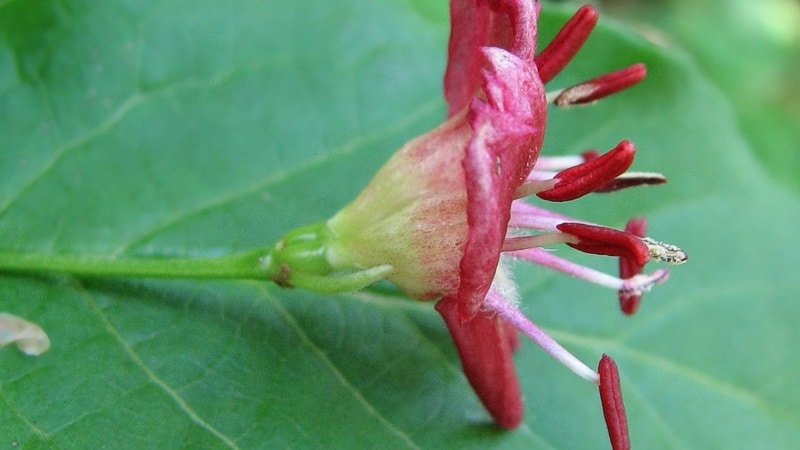
Productivity and fruiting
On average, different varieties of alpine honeysuckle begin to ripen bright fruits in July-August. The varieties “Linda” and “Aidar” demonstrate the earliest periods of fruiting.
Inedible berries are not subject to collection. They are used in small quantities only for the purpose of preparing seeds. After planting, the decorative crop usually begins to bear fruit in 4-6 years.
Resistance to diseases and pests
Alpine honeysuckle has a high rate of disease resistance. This plant is rarely damaged by harmful insects.
Resistance to cold and drought
Alpine honeysuckle belongs to the list of ornamental shrubs that easily adapt to different conditions.
The unpretentious crop is highly frost and drought resistant. Shrubs tolerate temperatures down to -45 °C well in the winter season. In spring, the flowers will not be damaged even by frosts down to -7 °C.
For which regions is it best suited and what are the climate requirements?
Alpine honeysuckle is successfully cultivated on the Russian European territory stretching from the southern regions to the latitude of St. Petersburg.
Shows sufficient winter hardiness in gardens and parks of the Moscow region. Considering the southern origin of the shrub, the most suitable climatic conditions for alpine honeysuckle are in the Central Black Earth region.
The main advantages and disadvantages of the variety
Alpine honeysuckle with its magnificent decor can decorate any corner of the garden. This culture also has other advantages:
- high rate of adaptability to new conditions;
- preservation of decorative qualities even during a long dry period;
- good winter hardiness;
- ability for successful seed propagation;
- regular growth of shoots;
- resistance to pest damage and disease development.
Among the disadvantages, there is mainly the inability to eat juicy fruits.
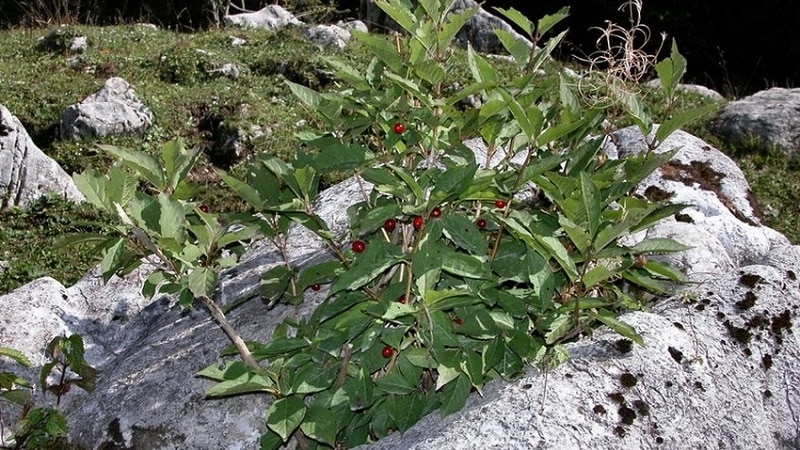
What is the difference from other varieties and hybrids
There are several varieties of decorative honeysuckle. The main distinguishing feature of alpine honeysuckle from them is its slow development.
The result is the formation of a compact bush with a beautiful, neat crown, densely strewn with dark green foliage.
Agricultural technology
Growing alpine honeysuckle yourself is not difficult, but requires compliance with a number of agrotechnical techniques.
Choosing a place in the garden and preparing holes
When planning a site In order to plant alpine honeysuckle, the main characteristics of this plant are taken into account.
The shrub develops well with long-term shading, maintaining lush greenery. But to obtain abundant flowering and then rich fruiting, it is recommended to select a place well illuminated by sunlight.
Attention! Seedlings should not be placed in lowlands, as excessive waterlogging of the soil negatively affects the development of the root system, provoking rotting processes.
Planting holes with a diameter of 0.5 m are made with a depth of 0.6 m. At their bottom, even with deep aquifers, drainage is laid using gravel, crushed stone, expanded clay, and brick fragments. Its thickness is 7-10 cm.
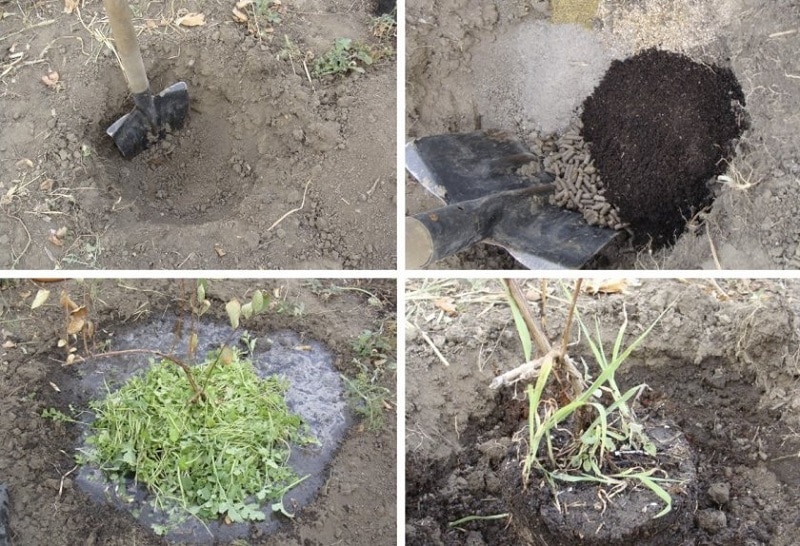
Preparing for landing
For good adaptation of seedlings, specimens with a well-developed, powerful root system without damage are selected.
The planting material is inspected and the dry areas are carefully trimmed with pruners with sharp, disinfected blades.
Soil requirements
Alpine honeysuckle takes root on different types of soil. If necessary, it can be planted on depleted sandy loam, fairly nutritious light loam, heavy clay and even rocky soil.
But to get a gorgeous bush with thick branches, strewn with glossy, richly colored leaves, and abundant flowering, you should select a place on the site with fertile, moderately moist, well-drained soil.
Dates, scheme and rules of planting
For alpine honeysuckle, which has a late growing season, spring is preferable landing. Seedlings sold with a closed, well-developed root system can also be planted during the summer season. Autumn planting is possible throughout September.
Important! When preparing planting holes, maintain a minimum interval of 2.5 m. This will prevent them from being shaded by each other as the bushes develop.
Landing algorithm:
- Humus, combined in equal proportions with garden soil, is poured into the center of the prepared hole. Add potassium sulfate (45 g) and superphosphate (70 g). Stir and form a low mound.
- Place the seedling vertically.
- The roots are carefully straightened.
- The voids are filled with fertile soil mixture, lightly compacting each layer. The root collar can be buried 20 mm or left level with the ground surface.
- Place sides around the trunk of the planted plant and pour in a bucket of settled water.
To slow down the evaporation of moisture, mulch the soil surface with crushed dry peat.
Features of cultivation
Alpine honeysuckle amazes with its amazing vitality.Even if it is impossible to plant bushes in a well-lit place, you will not have to give up this ornamental crop that can adapt to shady conditions.
The peculiarity of growing various varieties of alpine honeysuckle is that the stems of the seedlings do not need to be shortened immediately after planting.
Interesting things on the site:
Nuances of care
Despite the unpretentiousness and high adaptability of alpine honeysuckle, it is recommended to provide for the organization of a whole range of care measures.
- The bushes will not die even during a prolonged drought, but they will not be able to produce abundant flowering and high-quality fruiting. High decorative properties can only be maintained with systematic watering. The bushes will also like spraying the crown with clean water. Procedures are practiced in the evening or early in the morning. Water application rate - 25 l/m2. In dry, hot weather, watering is done every 5-6 days.
- The hard surface crust must be loosened, stimulating the flow of air to the roots and increasing the moisture absorption rate of the soil. Use a narrow hoe. The depth of loosening should not exceed 6 cm, which will avoid the risk of damage to roots located close to the surface.
- The tree trunk circles are covered with a layer of mulch. Rotted compost, crushed peat, and chopped straw are used. Such material not only retains moisture, but also helps loosen and increase the nutritional value of the soil.
- It is necessary to periodically weed out weeds, especially those with long powerful rhizomes. This will help preserve compounds important for the development of honeysuckle in the soil.
- In early spring, alpine honeysuckle requires sanitary pruning. Remove dry branches, as well as shoots with signs of damage by insects and diseases. Formative pruning is practically not required for slow-growing shrubs with a compact crown. In the fall, old drying shoots are removed, as well as branches growing horizontally near the soil, only from mature bushes. This rejuvenating pruning will help you get a beautiful plant next season.
- For feeding in May, nitrogen fertilizers are used to stimulate growth processes. At the flowering stage and in September, a phosphorus-potassium nutrient mixture will be required.
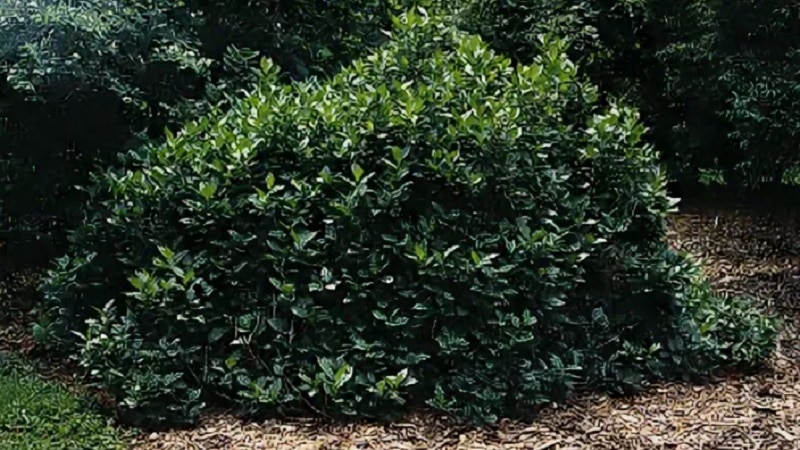
Pollinators
Despite the formation of a large number of bisexual flowers on alpine honeysuckle bushes in the spring season, the probability of self-pollination in this plant is low.
It is recommended to provide the possibility of crossover pollination, planting other varieties of honeysuckle at a distance of about 1.5 m. Pollen is carried by wasps, bumblebees, and bees.
Disease and pest control
Alpine honeysuckle plantings are systematically inspected. Under unfavorable conditions, this strong, viable plant may lose its decorative properties due to the appearance of harmful insects on the bushes or the development of diseases. The struggle will be effective if you start it at the initial signs of trouble.
A serious danger to honeysuckle are scale insects, honeysuckle mite, aphid. It is recommended to spray the plantings with tobacco or garlic infusion when these and other pests appear. When large populations of harmful insects are detected, Alatar, Actellik, and Confidor are used. Aktara shows good results.
In warm, excessively humid weather, the bushes are affected by powdery mildew.It is necessary to immediately trim and burn branches with signs of the presence of fungus, which include whitish coating and brownish marks. Then the bushes are sprayed with “Topaz” or “Ordan”.
The appearance of gray spots on the leaf blades with a characteristic burgundy edge indicates the development of cercospora blight, a dangerous fungal infection. For treatment, use “Fundazol”, Bordeaux mixture or copper sulfate.
Preparing for winter
Mature alpine honeysuckle bushes tolerate frost well. It is recommended to cover them only on the eve of a winter with little snow. The stems are tied and carefully bent, fixing them to the ground. Already before a strong cold snap, a non-woven fabric is thrown on. In winter, if possible, snow is placed on top.
For the winter, young seedlings are wrapped in burlap and covered with spruce branches. In spring, the shelter should be removed immediately after the snow cover melts. This will protect the stems from damping off.
Reproduction
Growing alpine honeysuckle is not a problem. This plant can be propagated in different ways.
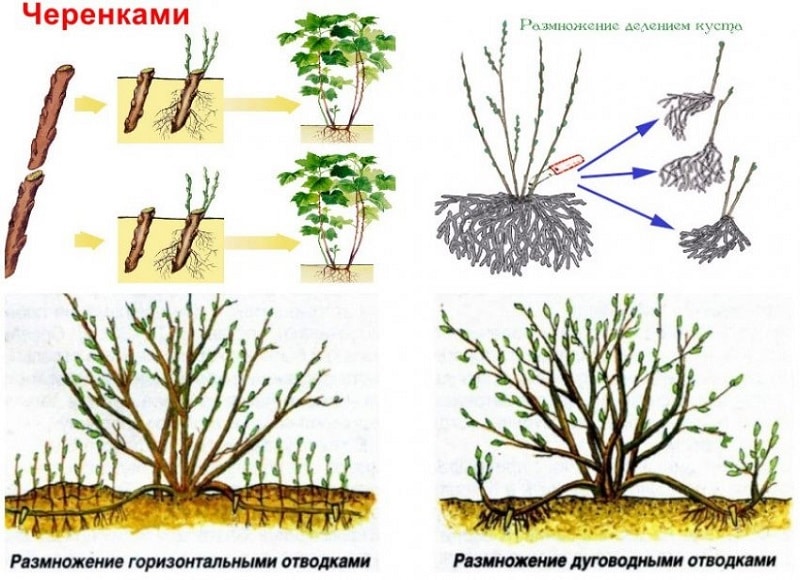
Seeds
Gardeners rarely practice the seed method, since the resulting seedlings lose their varietal characteristics. If desired, seeds are collected independently from bushes in the fall. Separate from the pulp and dry. Sowing begins in the spring, taking into account that germination is lost by the second year of storage.
Seeds require stratification. They are kept for 30 days at a temperature of 0 °C. For seedlings, seeds are planted in separate containers with loose, fertile soil. In the southern regions, you can sow directly into the ground not only in spring, but also in autumn (mid-October).
By layering
Reproduction by layering begins in the second or third decade of April. Healthy shoots are selected in the lower tier of the bush.The tops are cut off and sprayed with growth-stimulating drugs. The stems are tilted, lowering the bend into a shallow hole and sprinkled with earth, additionally secured with staples. It is necessary to water the layerings systematically. After 1.5-2 months, roots develop at the bend area. The seedling can be separated from the mother plant and transplanted to a designated area.
Cuttings
Alpine honeysuckle reproduces well cuttings - green or semi-lignified. The survival rate with this method is high. Green cuttings with 3-4 buds are harvested after the end of the flowering period. They are treated with a growth stimulator and planted in loose, fertile soil under a film. The seedlings will be ready for transplanting next year.
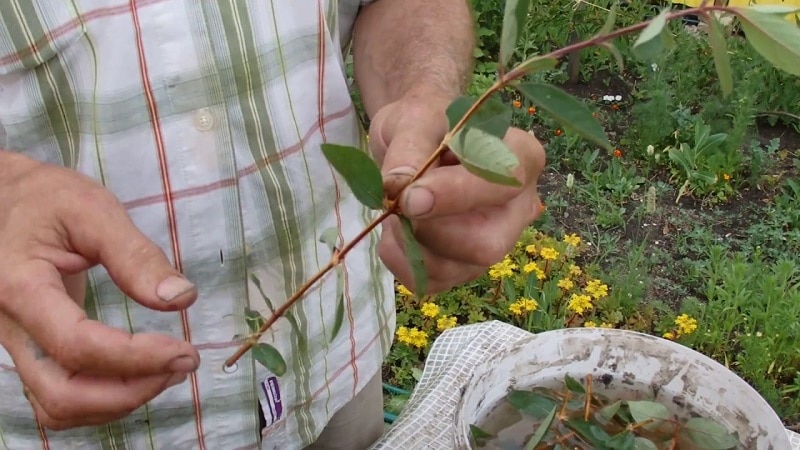
Semi-lignified cuttings are cut in September. After treatment with stimulants, the cuttings are placed obliquely in pots, buried 20-30 mm into the loose substrate. Keep at room conditions, periodically moistening the soil.
Seedlings in the southern regions can be transplanted to the site in the fall, as roots form after 2-3 weeks. In areas with a changeable climate, cuttings are left until spring.
Read also:
Harvesting
The beautiful juicy fruits that ripen on the bushes of different varieties of alpine honeysuckle are not poisonous, but they are also unsuitable for consumption.
How and when to collect
If you need to prepare seeds, then start picking berries in August. By this moment, the moment of full maturity has arrived, therefore, germination will be maximum. Remove the required number of fruits from the bush so as not to disturb the external decor of the crown.
What difficulties may there be when growing
Typically, alpine honeysuckle does not create problems during cultivation. It is not difficult to choose a place for seedlings, although it is recommended to provide sufficient lighting. Avoid hollows where rain or flood water stagnates for a long time.
Difficulty may cause the need to plant other varieties of honeysuckle in the neighborhood to ensure lush flowering. In this case, it is necessary to ensure that the buds on them should develop at the same time.
Tips and reviews from experienced gardeners about the variety
Of interest are the recommendations of people who grow ornamental crops on their own plots.
Svetlana A. Astrakhan region.: “I purchased alpine honeysuckle seedlings of the Korochanka variety. I planted it near my favorite bench. Now my beauty is four years old. The bush reached a height of 1.1 m. The crown is hemispherical. In spring, it is strewn with red buds that harmonize perfectly with the dark green foliage. Already from mid-July, light red shiny incredibly attractive berries ripen, which do not fall off for three months. For variety, I want to select other varieties of this same unpretentious honeysuckle.”.
Olga P. Tula region.: “I learned about alpine honeysuckle from a friend. Three years ago she gave several green cuttings of the winter-hardy variety “Aidar”. I can say that this culture does not lose its attractiveness from spring to autumn. It has gorgeous red buds, ovate-round green leaves, and oval dark red fruits that last almost until the end of autumn. A wonderful ornamental plant decorates the site very well.".
Conclusion
Alpine honeysuckle, growing in harsh mountain conditions, served as the basis for breeders to create decorative, unpretentious varieties. They are cultivated not only for the purpose of decorating public gardens and parks. Many gardeners appreciate the advantages of the compact shrub, which amazes with its unique decor throughout the growing season.